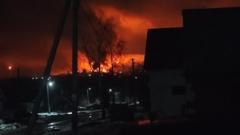The emergence of uncharacterized drones over military facilities in Europe signals a shift towards hybrid warfare, prompting defense officials to reassess their response strategies.**
Escalating Drone Incidents: A New Front in Hybrid Warfare**

Escalating Drone Incidents: A New Front in Hybrid Warfare**
Growing drone activity raises concerns of state-sponsored espionage and hybrid tactics against the West.**
The landscape of international security is rapidly evolving as governments grapple with increasing incidents of unidentified drones operating above strategic locations. These occurrences, once treated with skepticism, are now garnering serious attention from defense officials who categorize them as potential hybrid warfare tactics employed by hostile states.
In recent years, especially around Norway's oil rigs and wind farms, mysterious drones have raised alarms. Initially viewed simply as technological anomalies, experts like Stale Ulriksen from the Royal Norwegian Naval Academy believe they signify something far more concerning. “Some of it was espionage,” Ulriksen noted. “Some of it, I think, was positioning in case of a war or a deep crisis.” The drones, suspected to be launched from Russian-controlled vessels, operated over international waters, leaving Norway with limited options for counteraction.
The United States is experiencing similar unease, particularly following recent sightings along its East Coast. Out of approximately 5,000 drone reports, only a small fraction demanded further scrutiny, with no confirmed foreign surveillance drones identified thus far. However, the situation becomes alarming around U.S. military bases in England and Germany, where expert analyses suggest the drones might be engaged in coordinated surveillance efforts, likely state-sponsored.
Military and intelligence analysts now warn that these drone activities are indicative of hybrid or “gray zone” warfare. Such operations blend military strategy, cyber tactics, economic pressure, and psychological operations. This nuanced form of aggression allows for destabilization without direct confrontation, complicating responses from affected nations.
As these drone incidents escalate, defense officials are now faced with the pressing challenge of how to effectively counter these discreet yet provocative actions in a world where the conventional rules of engagement are shifting dramatically.
In recent years, especially around Norway's oil rigs and wind farms, mysterious drones have raised alarms. Initially viewed simply as technological anomalies, experts like Stale Ulriksen from the Royal Norwegian Naval Academy believe they signify something far more concerning. “Some of it was espionage,” Ulriksen noted. “Some of it, I think, was positioning in case of a war or a deep crisis.” The drones, suspected to be launched from Russian-controlled vessels, operated over international waters, leaving Norway with limited options for counteraction.
The United States is experiencing similar unease, particularly following recent sightings along its East Coast. Out of approximately 5,000 drone reports, only a small fraction demanded further scrutiny, with no confirmed foreign surveillance drones identified thus far. However, the situation becomes alarming around U.S. military bases in England and Germany, where expert analyses suggest the drones might be engaged in coordinated surveillance efforts, likely state-sponsored.
Military and intelligence analysts now warn that these drone activities are indicative of hybrid or “gray zone” warfare. Such operations blend military strategy, cyber tactics, economic pressure, and psychological operations. This nuanced form of aggression allows for destabilization without direct confrontation, complicating responses from affected nations.
As these drone incidents escalate, defense officials are now faced with the pressing challenge of how to effectively counter these discreet yet provocative actions in a world where the conventional rules of engagement are shifting dramatically.





















